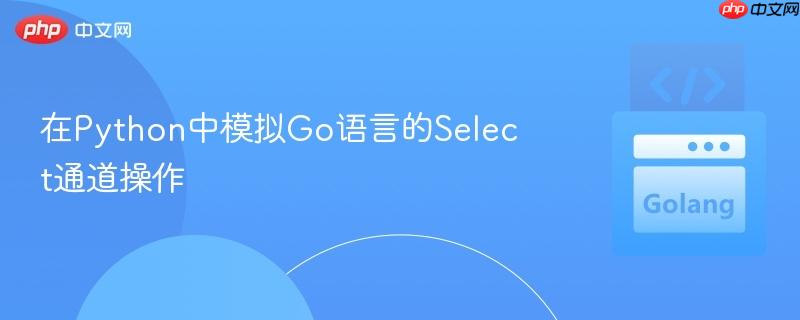
本教程探讨了如何在python中模拟go语言强大的`select`语句,以实现对多个并发通信通道的监听和处理。通过结合python的`threading`模块和`queue`数据结构,文章展示了如何构建一个中央消息转发机制,从而高效地管理来自不同生产者线程的消息,并提供了一个可复用的`select`函数实现,同时分析了与go原生`select`的异同。
1. Go语言select语句概述及其在并发编程中的作用
Go语言的select语句是其并发模型中的一个核心特性,它允许Goroutine同时等待多个通信操作(即通道操作)。当多个通道都准备好进行通信时,select会随机选择一个执行;如果只有一个通道准备好,则执行该通道的操作;如果所有通道都未准备好,select会阻塞直到其中一个通道准备就绪。这种机制极大地简化了复杂的并发模式,如超时处理、优先级处理和优雅地关闭Goroutine等。
在Python中,虽然没有直接对应的select语句,但我们可以利用其内置的threading模块和queue(Python 2中为Queue)数据结构来模拟类似的行为,以实现多通道的并发监听。
2. 基于线程和队列的select模拟实现
立即学习“Python免费学习笔记(深入)”;
为了在Python中模拟Go的select行为,我们需要解决两个主要问题:如何表示通道,以及如何监听多个通道并响应第一个就绪的通道。
下面是一个基本的实现示例,它模拟了Go语言中一个典型的select使用场景:
import threading
import queue # 在Python 3中,Queue模块被重命名为queue
def main_simulation_basic():
# 模拟Go语言中的通道
c1 = queue.Queue(maxsize=0)
c2 = queue.Queue(maxsize=0)
quit_channel = queue.Queue(maxsize=0) # 使用更具描述性的名称
# 模拟Go语言中的Goroutine:生产者函数1
def producer_func1():
for i in range(10):
c1.put(i)
quit_channel.put(0) # 完成后发送退出信号
# 启动生产者线程1
threading.Thread(target=producer_func1).start()
# 模拟Go语言中的Goroutine:生产者函数2
def producer_func2():
for i in range(2):
c2.put(i)
# 启动生产者线程2
threading.Thread(target=producer_func2).start()
# 创建一个中央队列,用于收集所有通道的消息
combined_queue = queue.Queue(maxsize=0)
# 辅助函数:监听一个队列并将消息转发到combined_queue
def listen_and_forward(source_queue):
while True:
# 获取消息,并将其与源队列一起放入combined_queue
# (source_queue, message) 这种元组结构用于标识消息来源
message = source_queue.get()
combined_queue.put((source_queue, message))
# 注意:这里需要一个机制来优雅地停止这些转发线程,
# 否则它们会一直运行。对于本例,我们依赖主线程退出时守护线程自动终止。
# 为每个通道启动一个转发线程
t_c1 = threading.Thread(target=listen_and_forward, args=(c1,))
t_c1.daemon = True # 设置为守护线程,主线程退出时自动终止
t_c1.start()
t_c2 = threading.Thread(target=listen_and_forward, args=(c2,))
t_c2.daemon = True
t_c2.start()
t_quit = threading.Thread(target=listen_and_forward, args=(quit_channel,))
t_quit.daemon = True
t_quit.start()
# 主循环:从combined_queue中获取消息并处理
while True:
which_queue, message = combined_queue.get()
if which_queue is c1:
print(f'Received value from c1: {message}')
elif which_queue is c2:
print(f'Received value from c2: {message}')
elif which_queue is quit_channel:
print('Received quit signal. Exiting.')
break # 收到退出信号,终止循环
# 调用主模拟函数
if __name__ == '__main__':
main_simulation_basic()在这个实现中,producer_func1和producer_func2是模拟并发生产者的函数,它们将数据放入各自的c1和c2队列。listen_and_forward函数为每个通道创建了一个守护线程,负责将消息转发到combined_queue。主循环则从combined_queue中取出消息,并根据消息的来源(which_queue)进行相应的处理。当从quit_channel收到信号时,程序优雅地退出。
3. 封装为可重用的select函数
上述模式虽然有效,但每次需要监听多个通道时都需要重复编写创建转发线程和主循环的逻辑。我们可以将其封装成一个可重用的select函数,使其更接近Go语言的简洁性。
我们可以设计一个select生成器函数,它接受任意数量的Queue对象作为参数,并持续yield出接收到的消息及其来源。
import threading
import queue # 在Python 3中,Queue模块被重命名为queue
def select(*queues):
"""
一个模拟Go语言select语句的Python生成器函数。
它接受多个Queue对象,并持续yield出 (源队列, 消息) 元组。
"""
combined_queue = queue.Queue(maxsize=0)
def listen_and_forward(source_queue):
while True:
try:
message = source_queue.get()
combined_queue.put((source_queue, message))
except Exception as e:
# 实际应用中可能需要更复杂的错误处理或停止机制
print(f"Error in listen_and_forward for {source_queue}: {e}")
break
# 为每个传入的队列启动一个守护转发线程
for q in queues:
t = threading.Thread(target=listen_and_forward, args=(q,))
t.daemon = True
t.start()
# 主循环:持续从combined_queue中获取消息并yield
while True:
yield combined_queue.get()
def main_simulation_reusable():
c1 = queue.Queue(maxsize=0)
c2 = queue.Queue(maxsize=0)
quit_channel = queue.Queue(maxsize=0)
def producer_func1():
for i in range(10):
c1.put(i)
quit_channel.put(0)
threading.Thread(target=producer_func1).start()
def producer_func2():
for i in range(2):
c2.put(i)
threading.Thread(target=producer_func2).start()
# 使用封装后的select函数
for which_queue, msg in select(c1, c2, quit_channel):
if which_queue is c1以上就是在Python中模拟Go语言的Select通道操作的详细内容,更多请关注php中文网其它相关文章!

每个人都需要一台速度更快、更稳定的 PC。随着时间的推移,垃圾文件、旧注册表数据和不必要的后台进程会占用资源并降低性能。幸运的是,许多工具可以让 Windows 保持平稳运行。

Copyright 2014-2025 https://www.php.cn/ All Rights Reserved | php.cn | 湘ICP备2023035733号